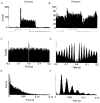Responses of neurones of the rat suprachiasmatic nucleus to retinal illumination under photopic and scotopic conditions
- PMID: 10673556
- PMCID: PMC2269794
- DOI: 10.1111/j.1469-7793.2000.t01-1-00211.x
Responses of neurones of the rat suprachiasmatic nucleus to retinal illumination under photopic and scotopic conditions
Abstract
1. We have examined the responses of neurones in the suprachiasmatic nuclei (SCN) of the rat to retinal illumination under photopic and scotopic conditions to identify the types of photoreceptor input to these nuclei. 2. The majority of visually responsive SCN neurones studied under dark adaptation received rod input (48 of 52, 92 %). The action spectrum conformed to the sensitivity of rhodopsin, with maximal sensitivity at around 505 nm. 3. When also studied under light adaptation, most visually responsive SCN neurones (20 out of 26, 77 %) responded to input from cones. The action spectra conformed to the spectrum of green cone opsin, with a main sensitivity peak at 510 nm and a significant secondary peak in the near-ultraviolet region of the spectrum. 4. The frequency of spontaneous activity was typically low under scotopic conditions (range 0.2-17.2 Hz) and higher under photopic conditions (range 0.6-40 Hz) for any given neurone. The most common response under scotopic conditions was an 'on-excitation' (32 of 48, 62.5 %), which changed under photopic conditions to an on-excitation followed by a more prominent off-inhibition. 5. Responses also changed due to endogenous ultradian cycles. Depending on the phase, responses could be altogether absent and even reverted from excitation to inhibition on opposite phases of a cycle. Ultradian cycles had a circadian dependence and were most common at around the light phase:dark phase (L:D) and D:L transition points of the circadian cycle. 6. Under photopic conditions, SCN neurones showed rhythmic electrical activity, with a preferred firing interval that had a value between 18 and 39 ms. This rhythmic activity was probably the result of endogenous subthreshold membrane potential oscillations. 7. In conclusion, light acting either via rod or cone pathways could have powerful, opposing actions on SCN neurones. These actions were state dependent. The presence of these neuronal responses suggests a role for rod and cone photoreceptors in SCN function.
Figures







References
-
- Amir S, Robinson B. Ultraviolet light entrains rodent suprachiasmatic nucleus pacemaker. Neuroscience. 1995;69:1005–1011. - PubMed
-
- Brainard GC, Podolin PL, Leivy SW, Rollag MD, Cole C, Barker FM. Near-ultraviolet radiation suppresses pineal melatonin content. Endocrinology. 1986;119:2201–2205. - PubMed
-
- Bronstein DM, Jacobs GH, Haak KA, Neitz J, Lytle LD. Action spectra of the retinal mechanism mediating nocturnal light-induced suppression of rat pineal gland N-acetyltransferase. Brain Research. 1987;406:352–356. - PubMed
-
- Colwell CS, Kaufman CM, Menaker M, Ralph MR. Light-induced phase shifts and fos expression in the hamster circadian system: the effects of anesthetics. Journal of Biological Rhythms. 1993;8:179–188. - PubMed
MeSH terms
LinkOut - more resources
Full Text Sources
Other Literature Sources

